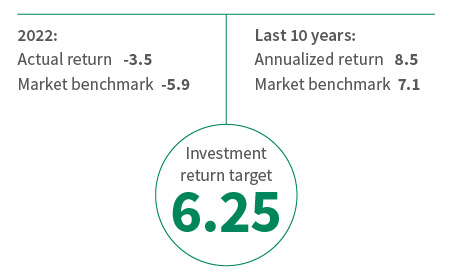How the plan decides where to invest
Investing for such a large plan is complex. Policies help Municipal Pension Board of Trustees decide how and where to invest.
Measurement
The board monitors progress in two ways: by comparing results to a market benchmark and an investment return target, and by ensuring investments are on track through regular actuarial valuations.
Benchmarks
A benchmark is a standard used to measure the performance of an investment or a portfolio. The plan uses benchmarks for total investment returns over the course of 1 year, 5 years and 10 years. It also sets benchmarks for specific types of asset classes, such as real estate.
The Statement of Investment Policies and Procedures identifies the benchmarks. These include specific broad markets such as Canadian and US stock markets, TSX and S&P 500.
Investment return target
While the board reviews investment returns quarterly and provides an annual report, it expects years with lower returns and looks beyond current performance. Our long-range investment return target is 6.25 per cent. While annual investment returns vary, this figure is used to measure the plan’s returns over the long term.
Investment return overview (%)

Actuarial valuations
Your plan uses actuarial valuations to measure the plan’s funding. Every three years, an independent financial expert (called an actuary) performs a valuation. This valuation shows whether the plan is on track to meet its goals. As part of each valuation, the actuary defines an assumed long-term rate of investment return for the plan.
Before each actuarial valuation, the board reviews the funding policy, which provides guidelines for managing the financial position of the plan.
